Siemens Energy & Automation, Inc. is debuting its new SINUMERIK 802D solution line computer numerical control (CNC) at this year's EASTEC show in West Springfield, MA. By combining the network-centric architecture of SINUMERIK solution line and SINAMICS, the new and innovative drive technology from Siemens, standalone as well as plant-wide automation solutions can be efficiently designed.
The SINUMERIK 802D is an operator panel-based control system that combines the numerical control (NC), the programmable logic controller (PLC) and the human machine interface (HMI) in a single unit. It has the capability of five-axis machining (two of which may be spindles) and is the ideal solution for the low- and medium-range milling and turning machine markets.
Benefits for end-users include increased efficiency and productivity; convenient operation and programming through advanced programming support such as Siemens' ShopMill and ShopTurn; and perfect handling through the use of commercially available compact flash (CF) boards for the storage, transmission and processing of part programs. Additionally, standard Ethernet and PROFIBUS protocols are used for machine tool communication.
For the first time, "thin client technology" is being used for operator input. The drives communications system, called "DRIVE-CLiQ", provides improved diagnostics and fast drive recognition via the electronic type plate.
The new SINUMERIK solution line is fully compatible with the existing SINUMERIK CNC family. This provides users with the peace-of-mind when changing to the new system platform. It is a secure, future-proof and innovative investment for both machine tool manufacturers and end-users alike.
Friday, March 31, 2006
CNC Platform is suited for milling and turning machines
Posted by
CNC-on-NET
at
1:02 AM
0
comments
![]()
Thursday, March 30, 2006
Rapid flow modeling for CATIA V5
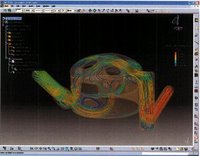 Fluent Inc., the worldwide leader in computational fluid dynamics (CFD) software and services, announces the immediate release of FLUENT for CATIA V5. With this new product, Fluent delivers its rapid flow modeling technology into Dassault Systemes' CATIA V5 product lifecycle management (PLM) environment. By providing a high degree of automation and robustness, rapid flow modeling allows fluid flow analysis to be applied early in the design cycle, resulting in improved design performance and reduced time to market.
Fluent Inc., the worldwide leader in computational fluid dynamics (CFD) software and services, announces the immediate release of FLUENT for CATIA V5. With this new product, Fluent delivers its rapid flow modeling technology into Dassault Systemes' CATIA V5 product lifecycle management (PLM) environment. By providing a high degree of automation and robustness, rapid flow modeling allows fluid flow analysis to be applied early in the design cycle, resulting in improved design performance and reduced time to market.
As a fully integrated tool within Dassault Systemes' V5 PLM environment, FLUENT for CATIA V5 is totally compatible with upstream and downstream PLM functions and enables flow simulation to be performed with ease as part of the product development process. Designed to match the workflow of native CATIA analysis tools, FLUENT for CATIA V5 can be easily adopted by current CATIA users. Operating completely within native V5 data structures, FLUENT for CATIA V5 is fully generative and supports parametric modeling, knowledge-based engineering, and analysis-driven optimization studies within the CATIA PLM system. Consistent with Fluent's rapid flow modeling vision, the product uses automation to dramatically lower the product's learning curve, allowing even occasional users to deliver quick robust engineering design validation studies throughout a product's lifecycle. FLUENT for CATIA V5 is fully upward compatible with the FLUENT 6.2 product line in order to support the most complex and detailed CFD simulation tasks possible.
"FLUENT for CATIA V5 delivers on the promise of a highly automated and robust flow simulation capability that operates completely within the PLM workflow," notes Paul Bemis, Vice President of Marketing at Fluent Inc. "By working closely with Dassault Systemes throughout the development of this solution, Fluent has been able to introduce technology advances for CFD in the CATIA V5 platform and deliver a first product release with an unprecedented level of integration and simulation capability. We plan to build on this foundation to help our customers fully deploy CFD analysis within their PLM vision."
"FLUENT for CATIA V5 is a result of the partnership between Dassault Systemes and Fluent, the industry leader in CFD," says Dale Berry, Director, Industry Solutions, SIMULIA. 'The general trend of using integrated analysis as a decision support tool for the early design stage of a product is being driven by our users. This fully embedded and optimized CFD solution involving proven technology in our user's V5 PLM environment will accelerate their product development process. This collaboration with FLUENT demonstrates the power of the open SIMULIA platform and our CAA V5 architecture to deliver simulation tools for engineers involved in product design."
"We are excited to announce this first release of our CFD solution for CATIA V5," says Laurent Collonge, Product Manager of FLUENT for CATIA V5. "The product is the result of an outstanding technical collaboration between Fluent, Dassault Systemes, and our customer advisors, who have helped us to ensure that this first release meets their need for ease-of-use, reliable simulation results, and a high level of integration."
FLUENT for CATIA V5 will be demonstrated at the upcoming CATIA Operators Exchange (COE) Annual PLM Conference and TechniFair in Atlanta, Georgia, from the 19 - 22 March. http://www.coe.orQ/events/06conference.
Posted by
CNC-on-NET
at
6:49 AM
0
comments
![]()
Wednesday, March 29, 2006
Profiling of PCD tools on wire EDM
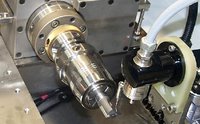 The new PCD Edge(TM) System allows quick and precise profiling of polycrystalline diamond (PCD) cutting tools using a Fanuc iC Series wire EDM machine. Available from Methods EDM, the system consists of advanced programming/probing/cutting software, a microfinish power supply/generator optimized for cutting PCD, a Hirschmann rotary axis, a Renishaw probe (mounted on the EDM machine), and a tool clamping system. Ideal for PCD tooling OEMs, shops that maintain their own tooling, and contract sharpening services, the system can be used to create original profiles or to sharpen (restore profiles on) worn PCD-tipped tools.
The new PCD Edge(TM) System allows quick and precise profiling of polycrystalline diamond (PCD) cutting tools using a Fanuc iC Series wire EDM machine. Available from Methods EDM, the system consists of advanced programming/probing/cutting software, a microfinish power supply/generator optimized for cutting PCD, a Hirschmann rotary axis, a Renishaw probe (mounted on the EDM machine), and a tool clamping system. Ideal for PCD tooling OEMs, shops that maintain their own tooling, and contract sharpening services, the system can be used to create original profiles or to sharpen (restore profiles on) worn PCD-tipped tools.
The PCD Edge System is quick and easy to use for even the most complex tools or profiles. Users can design tool edge contours on their own CAD systems, eliminating the need to learn a new system or change procedures. Intuitive and user-friendly, PCD Edge software provides special input masks to simplify parameter selection, program simulation, design modification, and verification. With no special programming knowledge, the user can create up to eight profile sections with specific parameters for each. Sophisticated software and a rotary axis permit adjustment of the relief angles on each contour element as well as automatic measuring (with feedback) of 3-dimensional PCD tip positions (rake and shear angles). With optional control software, the entire process (probing through program generation through cutting) can be automated for unattended operation.
Posted by
CNC-on-NET
at
12:34 AM
0
comments
![]()
VERICUT 6 simulates entire CNC machining process
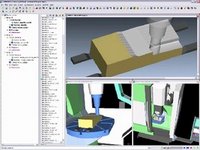 CGTech will preview VERICUT® 6.0 CNC machine simulation and optimization software at booth 5255 at the EASTEC Advanced Productivity Exposition May 23-25, 2006.
CGTech will preview VERICUT® 6.0 CNC machine simulation and optimization software at booth 5255 at the EASTEC Advanced Productivity Exposition May 23-25, 2006.
VERICUT 6.0 features several enhancements designed to increase the ability of manufacturing engineers to simulate the entire CNC machining process in order to produce better results and reduce the time spent in the programming and machining cycle. New features include:
- the ability to view and configure multiple setups in a single session.
- the capability to simulate machines with multiple synchronized tools, spindles and auxiliary attachments.
- a redesigned tool manager that simplifies NC program optimization.
- an enhanced Model Export option that now outputs features where possible and also "synthetic features" when individual features are not possible or desirable (such as "scallops" created by a ball endmill).
- the ability to create CNC probe programs and inspection sequences.
Posted by
CNC-on-NET
at
12:31 AM
0
comments
![]()
Tuesday, March 28, 2006
Airbus Chooses DELMIA V5 Manufacturing Software
IBM and Dassault Systèmes have announced that Airbus has chosen the DELMIA V5 Robotics digital manufacturing solution to simulate, validate and program the robotics assembly lines for the new Airbus aircraft programs. This choice will allow Airbus to optimize its design and manufacturing cycle time.
The first program to benefit from these solutions will be the A400M, the first Airbus aircraft entirely designed with CATIA V5 and simulated on DELMIA V5, from the range of IBM PLM solutions developed by Dassault Systèmes. This acquisition will enable Airbus to optimize programming time as well as fine-tune its production resources without disruption through Off-line Programming. The solution is enriched by the FASTIP-FASTRIM tools from Dassault Systèmes's technological partner CENIT, which work seamlessly on the CATIA and DELMIA V5 data-model to provide TRIMMING, DRILLING and riveting capabilities.
In addition to these robotic solutions, Airbus is using the ergonomic and assembly simulation tools of DELMIA V5 HUMAN and DELMIA V5 DPM Assembly to meet the increasing need for simulation in the field of digital manufacturing. Already used for the A400M program, it offers the ability to check accessibility during the assembly and maintenance phases of various plane parts throughout the design lifecycle.
The choice of this V5 robotics solution meets Airbus' global objective to cut costs and harmonize PLM tools on the V5 platform. The automatic solving of machine/environment conflicts will optimize machine paths, reducing maintenance costs and immobilization time.
“We have been working hand-in-hand for two years with the IBM, Dassault Systèmes and CENIT teams,” explains Daniel Girardot, robotics team leader at Airbus. “The three companies have designed a solution that totally fits with Airbus' methods and manufacturing processes, and will lead to significant profits for Airbus. It has been implemented first in 8 projects at different Airbus sites across Europe at the end of 2005.”
“To remain ahead of the competition, Airbus needs to constantly exceed its customers' expectations by providing a high level of quality, expertise, and added-value services, while cutting internal costs and time-to-market,” said Erick Craberou, director PLM Solutions, IBM France. “Our deep knowledge of this industry and our tight collaboration with Airbus allows us to provide Airbus with the right answer to meet its critical product development and innovation challenges.”
“DELMIA offers industry-leading advanced solutions in the digital manufacturing domain,” said Yves Coze, vice president sales, DELMIA Europe. “We have been providing Airbus with the latest simulation tools for many years, and our relationship continues to strengthen in robotics, allowing us to develop special applications for their use on our V5 platform. Certain advanced functions developed in partnership with Airbus have also been integrated into the standard V5 platform, making the benefits mutually beneficial.”
Posted by
CNC-on-NET
at
4:46 AM
0
comments
![]()
Monday, March 27, 2006
Industrial Laser enables high-throughput micromachining
 The new PRISMA(TM) 1064-32-V from Coherent, Inc. (Santa Clara, CA) is an industrial laser that delivers an optimum mix of high peak power, short pulsewidth, high average power and exquisite beam quality. This is an ideal combination for high-throughput, precision micromachining. In terms of specifications, PRISMA is a diode-pumped, solid-state, Nd:YVO4 laser that produces 30 W at 1064 nm in a TEM00 beam, with a pulsewidth as short as 18 ns, and pulse repetition rates from 20 to 100 kHz.
The new PRISMA(TM) 1064-32-V from Coherent, Inc. (Santa Clara, CA) is an industrial laser that delivers an optimum mix of high peak power, short pulsewidth, high average power and exquisite beam quality. This is an ideal combination for high-throughput, precision micromachining. In terms of specifications, PRISMA is a diode-pumped, solid-state, Nd:YVO4 laser that produces 30 W at 1064 nm in a TEM00 beam, with a pulsewidth as short as 18 ns, and pulse repetition rates from 20 to 100 kHz.
PRISMA is well suited for micromachining small features in all types of materials because its short pulsewidth results in a minimal heat-affected zone. Typical examples include solar cell processing, mold form manufacturing, deep engraving, and wafer scribing. (For applications that benefit from longer pulses, the PRISMA LP versions are offered.) In addition, the high average power of PRISMA enables these applications to be operated at high-throughput rates.
The new PRISMA 1064-32-V also offers superior reliability and stability, as well as low cost of ownership characteristics, due to its rugged construction, sealed resonator, and use of superior Coherent AAA(TM) (Aluminum-free Active Area) pump diode technology. As with all PRISMA series products, this laser can be readily tailored to precisely match its output characteristics to the needs of a specific application. In addition, PRISMA 1064-32-V is also available with a number of useful accessory options, such as a beam expander, visible aiming beam and mounting flange for scanner optics.
Posted by
CNC-on-NET
at
6:35 AM
0
comments
![]()
Friday, March 24, 2006
Remote Graphics Unit suits professional applications
Matrox Graphics Inc., the leading manufacturer of graphics solutions for professionals, announces Extio(TM) F1400, the world's first remote graphics unit. With this solution, the user interface of the computer -- the keyboard, mouse, monitors, audio peripherals, and graphics hardware -- are separated from the rest of the computer by up to 250 meters (820 feet) of fiber-optic cable. Designed for professional applications, this product supports up to 4 digital or analog monitors at a time, and has passive (fanless) cooling.
"Matrox remote graphics unit technology is ideal for a variety of mission-critical applications like computer-aided dispatch, security monitoring, and process control," says Samuel Recine, Product Manager, Matrox Graphics. "With its unique combination of features, this product can help save time and money, and increase system security."
Matrox Extio provides extra security and reliability by allowing the critical parts of a computer like the disks, memory, and processors to be kept in a separate, safe, secure room. This also saves space at the work station, removes a potentially noisy computer, and allows system administrators to access and maintain the system at a separate location. This technology has a better combination of integration, reliability, image quality, and distance than other extension technologies.
The versatile Matrox Extio F1400 remote graphics unit (RGU) has a Matrox-designed graphics chip, 128 MB of graphics memory, dual-LC connector for fiber-optic cable, 4 DVI-I monitor connectors, 6 USB 2.0 ports (4 in front, 2 in back), integrated audio hardware, an optical connector for digital audio output, and analog audio connectors for a microphone input, line input, and line output. To meet different slot requirements, Matrox separately offers PCI or PCI Express (PCIe) fiber-optic interface cards for Extio products.
Posted by
CNC-on-NET
at
12:46 AM
0
comments
![]()
Linear Servo Motor Slide
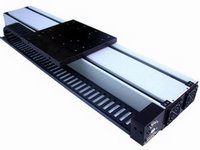 IntelLiDrives, Inc. released a new Linear ServoSLide(TM), pre-engineered linear servo motor slide, designed to eliminate backlash, friction and wear problems associated with the mechanical transmissions, such as ball/lead screws, rack & pinion and gearboxes.
IntelLiDrives, Inc. released a new Linear ServoSLide(TM), pre-engineered linear servo motor slide, designed to eliminate backlash, friction and wear problems associated with the mechanical transmissions, such as ball/lead screws, rack & pinion and gearboxes.
Linear ServoSLide(TM) features brush-less non-contact linear motor design with low cogging for fast and accurate positioning.
Double rail bearing system is integrated into the slide to support moving carriage and to provide dynamic stiffness and precise straightness of travel.
Precision non-contact linear position feedback with selectable resolution from 0.1 to 10 microns is mounted in the carriage to minimize thermal drift.
Limit Sensors are incorporated to establish end of travel and "home" positions.
Slide components are mounted in the high strength extruded aluminum housing precisely machined to provide outstanding straightness and flatness for installation in horizontal or vertical orientations.
Linear ServoSLide(TM) incorporates connector panel to provide "plug-in" connectivity and quick disconnect for all signal and power requirements as well as cable transport module with high flex robotic cable installed and pre-wired to the connector panel.
Multi-axes systems - gantries and XYZ robotic arms - can be easily constructed using multiple Linear ServoSLides(TM).
Features
o low profile
o high resolution
o multiple forcers in single housing
o matching digital servo-amp
o integrated "plug-and play" linear slide
Specifications
o force 100N to 2000N
o stroke 100mm to 5m
o resolution 0.1 to 10 microns
o accuracy 5 to 25 microns
o repeatability 1 micron
Posted by
CNC-on-NET
at
12:29 AM
0
comments
![]()
Thursday, March 23, 2006
Dassault Adopts 3D XML into Virtools Solutions
Dassault Systèmes announced the 3D XML format adoption in its '3D for All' flagship solutions, Virtools Dev 3.5 platform.
Dassault Systèmes' 3D For All strategy aims to make 3D technology available to users. This means that anybody from content creators right up to the product end user will have a set of solutions which allow them to imagine, share and experience in 3D. The adoption of 3D XML technology via a dedicated extension to Virtools' solutions is the first step towards providing a complete solution for recreating the end user experience on virtual products, with real-time interactive scenarios.
With this technology, PLM customers dramatically extend the benefits of using 3D technologies. The breadth of possible applications is huge. These include: simulation of product usage, ergonomic testing, creating the shopping experience, training scenarios, right through to branding, advertising and web marketing applications.
3D XML is a universal, lightweight XML-based format that enables users to share live, accurate 3D content quickly and easily. 3D XML is suited for fast and efficient communication, and provides unique features, such as multi-representational 3D content, and unmatched compression for complex, accurate geometry, enabling rapid communication and shorter load times.
Acquired by Dassault Systèmes in mid-2005, Virtools is the leading provider of comprehensive software solutions for building highly interactive 3D life-like applications.
Virtools 3D real-time technologies and solutions have been used in a wide variety of applications such as simulation of product usage, ergonomic testing, creating the shopping experience, training scenarios, right through to branding, advertising and web marketing applications.
A pioneer in the 3D software market since 1981, Dassault Systèmes develops and markets PLM application software and services that support industrial processes and provide a 3D vision of the entire life cycle of products from conception to maintenance.
Posted by
CNC-on-NET
at
2:10 AM
0
comments
![]()
Tuesday, March 21, 2006
Laser Scanner for large volume modeling
FARO Technologies, Inc., the world's only single source for a complete line of portable CAM2 solutions, announced the release of FaroScene 3.0 software for its Laser Scanner LS product.
"Since its launch last year, the new FARO Laser Scanner LS has brought high speed and high definition to the world of scanning," FARO Chairman, Co- CEO and Co-Founder Simon Raab said. "The enhancements in FaroScene 3.0 expand our Company's technological superiority beyond its traditional industrial base to industries such as Tunnel Excavation, Mining, Historical Preservation, Civil Engineering, as well as to the Forensic and Insurance Investigations."
The FARO Laser Scanner LS empowers users to digitize massive spaces into 3-D, action-ready data. Ideal for large-volume modeling, factory planning/redesign, quality control and forensics, it scans 120,000 points per second -- up to 100 times faster than most time-of-flight scanners -- with 3mm accuracy. The result is an image so detailed that it looks like a black-and- white photo, but in three dimensions that, thanks to FaroScene 3.0, one can use to instantly measure the distance between points, move in 3-D space and create CAD models for practically any application.
New features for FaroScene 3.0 include:
Noise Reduction and Simultaneous Volume Compression -- helps create high- definition scans more quickly.
Meshing/Surface Triangulation -- Point-cloud information becomes faster and often easier to handle as FaroScene creates a mesh of triangulated surfaces from individual points, which can then exported into other CAD systems. With meshing, unnecessary triangles are automatically eliminated, yet the scan still retains surface texture, so the file size is smaller without large segments of data being lost.
Edge Recognition -- This makes modelling in a CAD system as simple as possible. The 3-D grayscale data of the point cloud is used to generate an automatic edge model of the scan. Using this feature, edged objects can be easily extracted and used as the basis for modelling, then exported into other CAD systems in VRML or IGES format.
Visual Assessment of Registration Quality -- This gives the user a visual appraisal of which measurements would improve the registration, thus taking a further step toward intuitive quality improvement.
Automatic Object Fit -- Approximating a VRML object placed near the point cloud enables a faster comparison of the object to the scan data.
Free Downloadable Scan Viewer -- http://www.faro.com/ScoutLT contains a downloadable version of FARO Scout LT that enables users to navigate, export points to other software systems and to make measurements within the scan."The power to see a 3-D copy of the actual site, navigate through it and make critical decisions without visiting the site is an important capability for everyone from project managers in the construction industry, government officials in disaster recovery, and even insurance adjusters performing damage or risk assessments," FARO Director of LS Product Management Bernd Dietmar- Becker said.
Automatic Color Overlay -- The color option for the FARO Laser Scanner LS uses a digital camera to overlay color pixels on the point-cloud data, which is especially practical and timesaving when capturing large areas in color.
Posted by
CNC-on-NET
at
11:40 PM
0
comments
![]()
Design Software for Formula One Programs
VISTAGY, Inc., the developer of engineering software that provides specialized design functionality to commercial CAD/PDM/PLM systems, today announced that Carbo Tech Composites, a leading manufacturing company and Formula One specialist, has selected VISTAGY’s FiberSIM® software as its composites design solution. The company will use the software to design and manufacture high-end composite parts for the motor sports industry, including all Formula One projects.
Due to the rigors of Formula One racing, composite parts must be durable enough to withstand many millions of load changes and be extremely light-weight for optimal vehicle performance, while conforming to all mandated safety provisions. Using FiberSIM’s flat pattern and new automated plybook generation capabilities, Carbo Tech engineers will streamline the materials design and lay-up process to quickly and accurately build composite parts that meet all customer specifications.
Plybooks enable engineers to identify, list and understand the actual sequence and relationships between the numerous plies that make up composite products. In the past, Carbo Tech designed each individual ply by manually creating sequential drawings and lists, consuming many hours of design time and risking manufacturing errors.
FiberSIM automatically generates 2D and 3D plybooks as well as cross sections, customized notes, multiple views, lay-up orientations, and all necessary documentation for composite parts manufacture, and shares the documents across the entire product development chain. As a result, Carbo Tech expects to significantly decrease product design and manufacturing times while ensuring part quality. The company will also use FiberSIM to create manufacturing data such as flat patterns for cutting or laser projection machines.
"Formula One engineers need to constantly design innovative composite parts as rapidly as possible to raise the bar on the competition and win on the circuit," said Ralf Brand, head of design at Carbo Tech Composites. "After evaluating FiberSIM, we are convinced that the software will enable us to more efficiently design, accurately simulate and reliably manufacture our most complex composite parts."
Posted by
CNC-on-NET
at
12:47 PM
0
comments
![]()
Monday, March 20, 2006
Cut-Off Machines feature rotating cutting head
 Graebener Group Technologies Ltd has announced the availability of the REIKA line of Compact rotating head tube cut-off machines, which cut and simultaneously face and chamfer the O.D./I.D. on both tube ends, saving time, manpower and floorspace. Unparalleled quality is achieved by holding the tube in a fixed position while the cutting head rotates thereby minimizing positioning error and eliminating any marking on the O.D. surface.
Graebener Group Technologies Ltd has announced the availability of the REIKA line of Compact rotating head tube cut-off machines, which cut and simultaneously face and chamfer the O.D./I.D. on both tube ends, saving time, manpower and floorspace. Unparalleled quality is achieved by holding the tube in a fixed position while the cutting head rotates thereby minimizing positioning error and eliminating any marking on the O.D. surface.
Compact machines currently deployed to European customer applications are producing at rates of up to 1,900 parts per hour making them a perfect choice for the high-volume automotive environment. The machines also have proven repeatability and consistently achieve tolerance rates of +/-0.05mm with Cpk>2.0. Capability includes ingoing tube length up to 65 feet and up to 3.5 inches in diameter with a minimum cut length less than 1.0 inch.
The rotary cut-off unit can be equipped either with standard carbide inserts or with roller blades for chipless cutting, depending on wall thickness and material. The clean, dry chipless cutting process reduces tooling cost and eliminates the need for washing operations thereby reducing initial investment and ongoing energy consumption.
The machines can be equipped with either Siemens or Allen Bradley Controls and all machines come with a state of the art tele-diagnosis system. All machine and tube transport axes are electromechanically driven eliminating the need for less reliable hydraulic systems. Subsequent measuring stations for length, roundness, straightness or customer specific measuring applications can be integrated with SPC-capability. Machines can also be equipped with flexible and fully automated stack out and bundling systems allowing a single operator to manage multiple machines simultaneously.
Posted by
CNC-on-NET
at
5:41 AM
0
comments
![]()
Friday, March 17, 2006
Die-Sinking EDM features Dynamic Process Control
 Charmilles has unveiled the new Roboform 550 series, a die-sinking EDM that integrates a new generation of numeric controls designed to ease use and improve efficiency.
Charmilles has unveiled the new Roboform 550 series, a die-sinking EDM that integrates a new generation of numeric controls designed to ease use and improve efficiency.
Similar in most aspects to the previously released Roboform 350, the new machine can handle much larger parts than its counterpart. The ample work area accommodates workpieces up to 47.24" wide by 33.46" deep by 15.75" tall, weighing up to 3530 lbs.
When designing the machine, Charmilles analyzed the findings of a survey of moldmakers to develop interface functions and optimize screen ergonomics, resulting in unequalled performance and operator comfort. Called Dynamic Process Control (DPControl), the system was created to be directly involved with the manufacturing process.
With interactive graphics and embedded e-documentation, the Roboform 550 series is compatible with existing system architectures since its DPControl is based on a standard Windows platform. System integration eliminates the need for further investments or special training. Already a standard in the industry, user-friendliness has been further enhanced to satisfy the demand for operator convenience.
With the new system, graphics illustrate all machining operations, facilitating intuitive and spontaneous comprehension by the operator. Electronic manuals allow the operator to instantly receive easy-to-understand information about the current function by simply pressing the F1 key on the keyboard. DPControl also suggests ideal electrode undersize, rationalizes the number of electrodes needed and organizes job sequencing according to preset priorities. Machining status information is transmitted to the operator via SMS and full reports are automatically created for job evaluation.
Posted by
CNC-on-NET
at
2:01 AM
0
comments
![]()
Thursday, March 16, 2006
Design Visionaries Resells 3DConnexion SpacePilot
Design Visionaries and 3Dconnexion have reached an agreement for Design Visionaries to resell 3Dconnexion’s SpacePilot. SpacePilot is the preeminent state-of-the-art device to control screen positioning of solid models.
SpacePilot features adaptive sensing technology that intelligently gives users exact functions desired, the instant needed. An array of extendable keys puts unlimited functions and functionality right at users' fingertips.
SpacePilot features:
• More than 21 adaptive and programmable speed keys
• Supports an array of office productivity, viewer and CAD design application
• SmoothZoom and SmoothScroll supported for enhanced panning and zooming
• QuickTaps for a no-look fast function access with just a tap on the motion controller
• Control panel for creating and saving user configurations
• Compact integrated motion controller and keyboard design
SpacePilot allows users to pan, zoom and rotate simultaneously 3D models and scenes. Navigation becomes more fluid and precise, resulting in a 30% gain in efficiency over using a mouse. SpacePilot features advanced ergonomics, with a soft-coated, sculpted palm rest providing a glove-like feel. The controller cap and programmable speed keys are easy to reach without taking your hand off the controller.
SpacePilot combines efficient navigation, advanced ergonomics and intelligent keys for fluid and effortless control over applications.
With over 100 years of combined experience, Design Visionaries’ knowledge and experience span a large range of engineering disciplines and industries. The team has worked in the fields of aerospace, medical, automotive, industrial, and consumer products and others.
Posted by
CNC-on-NET
at
12:15 PM
0
comments
![]()
Wednesday, March 15, 2006
CNC Coordinate Measuring Machine
The new Legex 574 CNC Coordinate Measuring Machine from Mitutoyo America Corporation combines state-of-the-art design, electronics, computing, sensors and materials to offer substantially enhanced performance while at the same time providing a significant price advantage.
Ultra-high accuracy (MPEE = [0.35+L/1000] µm), a large measuring range (X: 510mm, Y: 710mm, Z: 455mm) high traverse speed (200mm/sec.) and robust worktable loading capacity (200kgf) make the Legex 574 CNC-CMM both productive and practical in applications as diverse as measurement of large lenses to inspection of metallic molds, engine blocks and similar components, whether in production runs, or small lots.
The Legex 574 is driven by MCOSMOS (Mitutoyo Controlled Open System for Modular Operation Support) software with modules supporting virtually every CAD format while providing routines for in-line measurement, data feedback, and process management. MCOSMOS also makes training easy and intuitive.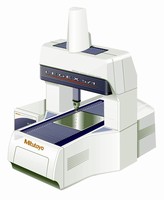
Construction of the Legex 574 incorporates the latest technologies. For example, spheroidal graphite ductile cast iron is used for the chassis which, together with air-damped spring isolators, effectively attenuate vibration. Legex 574 design used FEM (Finite Element Modeling) analysis to optimize its configuration to ensure outstanding geometric accuracy by minimizing the deformations caused by normal machine operations. Also, thermally-stable components and real-time temperature compensation maintain extremely high accuracy, even under a wide range of operating temperatures (64.4°F - 71.6°F / 18°C - 22°C).
A wide variety of probes is supported including contacting scanning and touch-trigger as well as laser and vision.
Posted by
CNC-on-NET
at
3:33 AM
0
comments
![]()
Tuesday, March 14, 2006
Parting and Grooving
Iscar new JET-CUT system features a coolant hole that passes through the insert to an outlet near the cutting edge. The new DGNC inserts are designed for parting and grooving operations on stainless steel and high temperature alloys. Often times when machining these materials, the temperature near the cutting edge becomes very high, thus causing premature wear. By applying coolant to the cutting zone this can be reduced.
The new JET-CUT inserts are also a great solution to grooving and parting applications where there is a problem getting coolant to the cutting edge. Sometimes in these applications the way the chip exits the workpiece prevents the coolant from reaching the cutting edge when traditional coolant delivery methods are applied. The new DGNC inserts are a great solution as the coolant travels through the insert and exits a hole directly next to the cutting edge.
This thereby applies coolant exactly where it needs to go while also internally cooling the insert at the same time. The application of coolant through this system has shown to increase tool life and provide a smoother surface finish. In addition, materials such as titanium, inconel, and austenitic stainless steel tend to strain harden during the cutting process and thereby produce long and tangled chips. By efficiently applying cooling through the JET-CUT system, flank and cratering rates are reduced thus substantially increasing tool life.
Coolant can be supplied either directly to the DGFH-C blades used on regular blocks, or through the SGTBU-C blocks which have coolant passages or connecting ports. Inserts are available in widths of .118" and .157" in the C- and J-type chipformers.
Posted by
CNC-on-NET
at
11:15 AM
0
comments
![]()
Tangential Geometry for Fast Metal Removal
Iscar is introducing a new family of tools for high production milling. The new MINITANG inserts from Iscar applies the tangentially clamped design of the larger TANGMILL tool to the smaller MINITANG inserts. These inserts feature four helical 0.315" long cutting edges. Due to the small size of the T490 LNMX 0804 PN-R inserts and their tangential orientation in the pocket, these tools have a larger core diameter design than regular radially oriented inserts. This combination of features produces Fast Metal Removal results on a variety of milling applications.
The T490 E90LN endmills can be used for machining 90° shoulders at high feed rates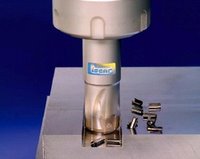 with no mismatch. Due to the helical cutting edge and positive rake angle, these inserts feature a soft and clean cut. In addition, the design of the new MINITANG tools makes it possible to use them on side plunging applications as well.
with no mismatch. Due to the helical cutting edge and positive rake angle, these inserts feature a soft and clean cut. In addition, the design of the new MINITANG tools makes it possible to use them on side plunging applications as well.
Currently the new T490 E90LN family of endmills is available in a variety of sizes. The smallest tool diameter available is 0.625", and the largest is 1.50". These are available with either coarse or fine pitch configuration for each diameter.
Posted by
CNC-on-NET
at
11:01 AM
0
comments
![]()
Friday, March 10, 2006
Mitutoyo Holtest Bore Gages now Titanium Nitride Coated
Holtest Bore Gages provide durability and abrasion resistance while making 3-point bore diameter measurements in range above 8 mm bore diameter. Pins made of hardened steel exhibit 1,700-2,000 Hv hardness and shear strength of 4,000 N/mm². Equipped with digital display and ABS scale with absolute origin, gauge also features constant-force ratchet that minimizes measurement variations between different operators.
The new line of Holtest bore gages from Mitutoyo America Corporation employ a titanium nitride coating to offer increased durability and abrasion resistance while making high accuracy, three-point bore diameter measurements.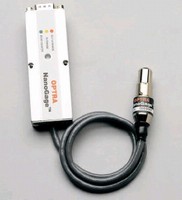
The measuring pin contact faces of the new Mitutoyo Holtest bore gages are coated with titanium nitride (Holtest and Digimatic Holtest models). As a result, the pins can be made of hardened steel instead of more brittle carbide, providing extra toughness to reduce the likelihood of contact faces being chipped during measurement.
The three-point design of the Holtest bore gages assures smooth, highly stable measurement in the ranges above 8mm bore diameter while a constant-force ratchet minimizes measurement variations between different operators. Optional extension rods can be fitted to enable measurement of deeper holes.
Digimatic Holtest bore gages are also equipped with an easy to read digital display and the ABS (Absolute) scale with absolute origin, which eliminates the necessity to set the origin at every power-on. The system also eliminates over-speed errors for increased reliability.
Posted by
CNC-on-NET
at
10:37 AM
0
comments
![]()
Position Sensor measures short-range displacement
 NanoGage is a small electro-optic sensor with performance equivalent to a precise capacitance gage but with a 3mm standoff, little sensitivity to electromagnetic interference and a large measurement bandwidth. NanoGage can fit a broad range of applications, such as: maintaining a closed-loop position, automated focusing at a specific surface height, run-out measurements, or vibration measurements. NanoGage is costeffective with a list price of $2,995.
NanoGage is a small electro-optic sensor with performance equivalent to a precise capacitance gage but with a 3mm standoff, little sensitivity to electromagnetic interference and a large measurement bandwidth. NanoGage can fit a broad range of applications, such as: maintaining a closed-loop position, automated focusing at a specific surface height, run-out measurements, or vibration measurements. NanoGage is costeffective with a list price of $2,995.
The Model 100 sensor has a small cylindrical package for easy installation. The sensoris approximately 0.5 inches in diameter and 2.2 inches long; the structural body of the sensor is made of aluminum. This product has a linear measurement range of 100 microns and a signal capture range of ± 400 microns. Its resolution is 15 nanometers rms at 100kHz measurement bandwidth.
The fundamental principle of NanoGage is the accurate triangulation of a reflected laser spot across a photoelectric detector. The optical sensor works with reflective surfaces; such as glass or metal. NanoGage 100 requires a minimum 4% surface reflectance for a specular target and works with smooth machined surfaces. This model has approximately a 100 micron diameter laser spot footprint at the target surface.
Posted by
CNC-on-NET
at
10:20 AM
0
comments
![]()
Thursday, March 09, 2006
One-touch axial adjustment
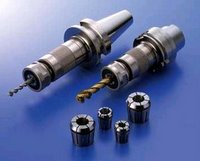 With the STM Tap Holding System, tap projection length can be adjusted simply by handrotating the guide ring on the outside of the toolholder. Axial adjustment range varies depending on the size of the STM Toolholder, but is as high as 15mm (0.591").Taps are securely held in place by one piece steel spring collets.
With the STM Tap Holding System, tap projection length can be adjusted simply by handrotating the guide ring on the outside of the toolholder. Axial adjustment range varies depending on the size of the STM Toolholder, but is as high as 15mm (0.591").Taps are securely held in place by one piece steel spring collets.
Taps are further prevented from rotating by interchangeable preset drivers that secure the squares on the tap shanks. The combination of spring collets and interchangeable preset drivers provides two benefits:
(1) a wide variety of tap sizes can be used with a single toolholder and
(2) higher accuracy than traditional spring-type tap collets.
The STM Tap Holding System is also designed to accommodate high pressure coolant. Thesystem can accommodate 1,000PSI of coolant pressure for tap sizes less than 19mm (0.748") and 725PSI of coolant pressure for tap sizes 20mm (0.787") and above. Coolant can be delivered either through the tap or along the side of the tap using the STM's patented onepiece steel collets.
The STM Tap Holding System is designed for use with machines that have a synchronizedtapping function. STM Toolholders are available in CT, BT, HSK and straight shank styles. Tap collets are available to accommodate metric, unified and pipe-taper thread taps in a wide variety of sizes up to M30 (metric), 1-1/8 (unified) or ¾ (pipe-taper).
Posted by
CNC-on-NET
at
1:54 AM
0
comments
![]()
Wednesday, March 08, 2006
CNC Grinder Perfects Punches
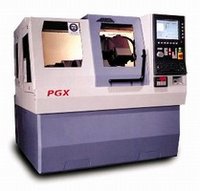 Specifically designed for grinding punches, the new ANCA PGX CNC Punch Grinder can grind round, eccentric, and step punches up to 150mm (6") in high speed steel and carbide and effectively uses both conventional and superabrasive grinding wheels.The large 762 mm (30") grinding wheel provides high stock removal rates, extends wheel life, and helps assure high quality surface finishes. The wheel speed is directly programmable via the CNC from 200 to 3000 rpm or at a constant surface speed for short cycle times.
Specifically designed for grinding punches, the new ANCA PGX CNC Punch Grinder can grind round, eccentric, and step punches up to 150mm (6") in high speed steel and carbide and effectively uses both conventional and superabrasive grinding wheels.The large 762 mm (30") grinding wheel provides high stock removal rates, extends wheel life, and helps assure high quality surface finishes. The wheel speed is directly programmable via the CNC from 200 to 3000 rpm or at a constant surface speed for short cycle times.
ANCA's new Toolroom(TM) software, Version 27, is packed with new features that extend the efficiency and range of application for the PGX. Designed to meet the demands of customers, Version 27 provides:
o Ability to include up to 1000 elements in each individual step in the punch, allowing development and grinding of much more complex punches as well as importation of many more IGES and DXF files.
o The efficiency of the ellipse grinding cycle has been improved up to 100%.
o Cylindrical grinding capabilities have been added to the PGX, including Traversing and Shoulder Grinding, which expands the versatility of the PGX.
The Toolroom software also provides the ability to program a wide range of generic punch shapes by selecting a suitable contour and entering a few key dimensions into the dedicated graphical interface.
The standard 2D editor is used to draw custom shapes. In addition to DXF and IGES files that contain complex shapes, multiple steps can also be imported allowing instant grinding without any need for additional programming.
A combination of tooling options such as dressers (single point or rotary), tailstock (manual, automatic and slimline), and loaders significantly extend the production capabilities of this powerful machine. Manual, pneumatic or slimline tailstock may be selected by users.
The PGX is capable of providing excellent surface finish and precision contours through the use of:
o Spindle power of 22kW (30HP)
o Digital servo drives
o Robust cast iron work head is specially designed for heavier irregular grinding forces required for punch grinding
o Automatic wheel balancer
o Direct drives in all axes as well as the grinding spindle
o Diamond dresser roll or single point dresser
Posted by
CNC-on-NET
at
3:09 AM
0
comments
![]()
Tuesday, March 07, 2006
Brushless DC Servomotor
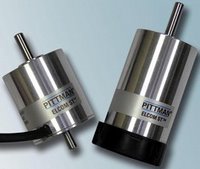 New PITTMAN® brand ELCOM ST® "Series 1300" slotted brushless DC servomotors can deliver more power in a smaller and cost-effective package to maximize design flexibility and satisfy application requirements where space may be minimal.
New PITTMAN® brand ELCOM ST® "Series 1300" slotted brushless DC servomotors can deliver more power in a smaller and cost-effective package to maximize design flexibility and satisfy application requirements where space may be minimal.
Despite their small size (1.3"/33mm diameter), these brushless DC motors can achieve peak torque from 12.6 oz-in to 54.3 oz-in and continuous torque from 5 oz-in to 9 oz-in, depending on model. Robust rotor construction allows rotational speeds up to 8000 RPM.
Three Hall sensors are incorporated as standard components to provide rotor position feedback for electronic commutation. Other standard features include 3-phase stator with 6-slot silicon steel laminations; 4-pole rotor integrating high-energy neodymium ring magnets for optimized motor performance; and large ABEC ball bearings with high dynamic load ratings (up to 390 lbs.) and shielded to protect against contaminants.
PITTMAN "Series 1300" brushless DC motors are available in three lengths (1.5", 2", and 2.5"); housed in precision-machined aluminum to promote lightweight designs; and include integral front-endbell. Optional square flanges can be specified for NEMA 14 mounting.
Motors can further be customized with a wide range of components to meet application demands, including planetary or spur gearboxes and optical encoders, among others.
Posted by
CNC-on-NET
at
5:27 AM
0
comments
![]()
Monday, March 06, 2006
3- and 5-axis machining
DP Technology has released ESPRIT Mold(TM), an automated, easy-to-use, robust and powerful 3-axis and 5-axis CAM system. This new product within the ESPRIT CAM software family incorporates over twelve years of accumulated expertise and comprehensive technology within the areas of 3-axis, 5-axis and high-speed machining. ESPRIT Mold is a member of the ESPRIT family of CAM software which also includes ESPRIT SolidMill(TM), ESPRIT SolidTurn(TM), ESPRIT SolidMillTurn(TM) and ESPRIT SolidWire(TM).
ESPRIT Mold is now available through the ESPRIT reseller network to the thousands of companies throughout the world involved in the production of models, prototypes, injection molds, die casting molds and sheet metal molds.
ESPRIT Mold 3-axis MachiningUtilizing knowledge of in-process stock, remaining material, and integrated simulation and verification ESPRIT Mold delivers fast, safe and reliable programming for a wide variety of 3D machining applications. With 20 different milling strategies, ESPRIT Mold automatically manages the in-process stock model, allowing the user to combine milling strategies from 2 ½-axis to 5-axis for optimized tool paths.
ESPRIT Mold 3+2 Machining optimizes machining for improved surface finish utilizing A and B axes to incline the cutting tools. The use of shorter, more rigid cutting tools and direct machining of undercut areas is therefore possible. With complete security, all rapid movements between machining zones, even with different index angles, are automatically generated collision free with respect to the in-process stock.
ESPRIT Mold 5-axis MachiningESPRIT Mold offers the benefit of automatic continuous 5-axis machining to maximize part quality and cutting speeds while reducing cycle times. ESPRIT Mold's automatic 5-axis takes any 3-axis tool path (Z level contour finishing, roughing or re/machining, etc.) and automatically converts it into a continuous 5-axis operation. A rich set of functions allows users to take profit from the latest 4- and 5-axis machine tools, while benefiting from ease of use.
Posted by
CNC-on-NET
at
5:03 AM
0
comments
![]()
Thursday, March 02, 2006
Hybrid Electric Buses Improve Fuel Economy
Hybrid electric transit buses are raising the industry standard for fuel economy, emissions, and reliability, according to a recently published independent study.
The National Renewable Energy Laboratory (NREL) compared different technologies used in regular revenue service in New York City and concluded that Orion VII buses powered by BAE Systems' HybriDrive® series propulsion system had superior performance. Orion is the transit bus brand of DaimlerChrysler in North America. "This is great news for any transit agency wanting to make a difference environmentally and control rising fuel and operating costs."
Hybrid buses tested by NREL on New York's most severe duty cycles achieved up to 45 percent better fuel economy than diesel buses and 100 percent improvement compared to natural gas on an energy-equivalent basis. The report also said bus drivers liked the increased power output of the hybrid buses, whose electric drive motor offers superior torque to help with acceleration and hill-climbing.
New York's hybrid fleet also proved most reliable in the study, with 7,000 miles between road calls, compared to 5,000 miles for natural gas and 4,000 miles for diesel. The HybriDrive® system also performed better than the other propulsion systems, with 10,000 miles between calls, compared to 8,000 miles for CNG and 5,000 miles for diesel.
In a series hybrid, the vehicle utilizes a smaller diesel engine, reducing weight and cost. All-electric drive maximizes efficiency and reduces emissions, and a regenerative braking system recovers waste energy and extends brake life. The design also eliminates the transmission, a significant maintenance item on transit buses.
The NREL study examined the operation, maintenance, performance, emissions, cost, and safety of urban transit buses operating in normal revenue service in New York, where usage and duty cycle are extremely demanding. The city operates a fleet of more than 4,000 transit buses including diesel, natural gas, and hybrid electric varieties. Currently, 325 Orion VII hybrid buses operate in revenue service, and 500 more are on order.
Orion is the leader in heavy-duty transit buses and was first to introduce clean diesel hybrid-electric technology to the North American market. Orion is a brand of DaimlerChrysler and utilizes the engineering, research and development, and financial backing of the world's largest bus and motorcoach manufacturer to provide superior products worldwide.
BAE Systems is the premier transatlantic defense and aerospace company delivering a full range of products and services for air, land and naval forces, as well as advanced electronics, information technology solutions and customer support services.
Posted by
CNC-on-NET
at
10:38 PM
0
comments
![]()
Wednesday, March 01, 2006
Friction Welding System
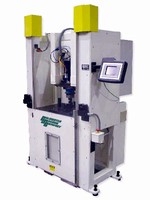
Coldwater Machine Company has taken its proven capability as a custom mechanical solutions supplier to become the key integrator for German-based Harms+Wende precision controlled, pneumatic, friction weld heads. The new turnkey friction welding system, Coldwater Machine Company model FWS-30, is designed for small part joining to a broad range of part configurations and dissimilar materials.
Friction welding is a process of joining parts utilizing heat generated by rotating one part at a high speed while bringing it into contact with the stationary part to which it will be welded. Once the temperature of the material has been achieved through rotational friction, the rotating element is stopped and pressure is applied causing the two parts to be welded together. This results in a forge-quality welded joint produced through process control of the predetermined parameters of time, rotational speed, pressure and temperature.
Some key advantages of the friction welding process over conventional methods include:
o Duplicating part-to-part consistency through controlled process parameters
o The ability to join unlike materials commonly considered not weldable (i.e.: Aluminum, High Carbon Steel, Ceramics, Bronze, Copper, etc.)
o Produces forge-quality welds with little or no diffusion area
o Significantly faster weld cycle times
o Environmentally cleaner and safer
o No consumables are required
o Well suited for a variety of part configurations
o Ease of welding pre-painted or coated components
o Optional process monitoring of weld parameters for statistical process control
With the Coldwater Machine FWS-30, the rotation of the weld head spindle is servo controlled. Precise rotational speeds from 12000 to 23400 rpm can be achieved and forging forces from 335 to 3125 lbf can be accurately applied for maximum weld integrity. These parameters are determined based off of part configuration, size of the part's contact surface area, and the composition of the materials involved. The friction weld head can accept parts with a footprint of up to 30 mm. Because the weld time required for actual friction welding is extremely fast, weld cycle times are easily reduced from minutes to seconds.
Coldwater Machine will configure the FWS-30 as a complete turnkey solution. The system can be designed as a stand alone machine, integrated into a work cell, or be part of an automated processing line. Coldwater Machine will design and manufacture all necessary, stationary or indexing, fixturing and tooling, and integrate, as required, with automated part feeding, or robotics for loading and unloading of parts, as well as complete part gauging. Coldwater Machine can provide weld samples for customer applications using customer provided workpieces, thereby, providing the customer with welded, production quality, test samples for evaluation.
Posted by
CNC-on-NET
at
3:59 AM
0
comments
![]()




